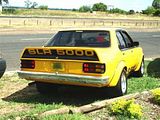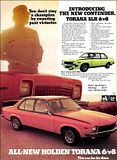SLR Torana
Torana SL/R 5000Torana is aboriginal for ‘to fly’, and in 1972 the new SL/R 5000 looked as if it had wings when compared to its rivals. In actual fact, the car looked quite plain with the exception of a rear spoiler, sporty wheel trims and SLR 5000 graphics. Then you opened the bonnet and your perception of this ‘plain Jane’ changed remarkably. In spite of the hysteria caused by the sheer thought of a V8-engined Torana back in mid 1972, it’s bizarre that the LH V8s attracted so little criticism. The new-fangled cars were indeed bigger and heavier but they were still called Torana, and with V8 engines planned to power Kingswoods, Premiers, Monaros and even Statesmans they looked as if they would live up to the name. This was the new car that would represent GMH at The Mountain, the successor to the already legendary XU-1. Regardless of their limitations, the LH Toranas were more competent family cars than their predecessors. Appreciated by their new owners, the extra 102mm of interior width and a smoother, quieter ride were attributes much needed for transporting four or five people plus luggage. As sporting machines, however, these V8 versions of the LH fell short of the mark. The XU-l had always been a purpose-built race car and the SL/R Torana was basically a family car with add-ons. But even the greatest add-on, the lusty 5047cc (308ci) small-block, failed to qualify the 1974 Torana as a true XU-I successor. However, while weight and size were up significantly, so too was power. With the SL/R 5000 developing 179kW (240bhp), on paper it certainly looked to have the goods. But any expectations of GT-HO-type standing quarter runs were disappointed. Regardless of what tyres were on the car, you couldn’t drive a stock SL/R 5000 over the quarter mile in much under 16 seconds. With 179kW at 4800rpm and 426Nm of pull at 3000rpm in a 1224kg car, this was exceptionally disappointing. The ContenderOn paper, the SL/R 5000 presented a performance package to better almost anything of similar size and certainly of similar price. In practice, the car demonstrated compromises that weren’t redressed by a minor improvement in performance over the six-cylinder XU-1. The SL/R 5000 remained an LH Torana built more for ride than handling, more for comfort than precision. Tossing a hefty lump of engine into a car of the Torana’s size demanded some serious structural engineering, and Holden made a decent first-up attempt. Hefty anti-roll bars fitted front and rear did their best to counteract body roll and vastly improved damping minimised the discomfort imposed on occupants of LC-LJ models. The steering rack was still mounted on rubber. Moving from recirculating ball to rack and pinion steering should have produced a significant improvement in feel and precision. It didn’t, and the lack of information coming back to the driver via the steering wheel produced immense criticism. There was still too much understeer when you really stuck the boot in through tight bends. If you were in the market for a family sedan with sporting overtones, particularly in performance and image, then the SL/R 5000 was not a bad thing. But if you wanted to speed around twisty roads then you would never have been able to regard the SL/R 5000 as a pure sporty car. The General’s advertising was of the full-on variety with lots of emphasis being given to the race track potential of the new top line Torana. It was described as “the new contender.” Go-faster partsLike all SL/Rs, the V8 version featured front and rear sway bars. Its interior was the same as any 3.3-litre SL/R; only a pair of spoilers distinguished the 5.0-litre externally, and that duck tail unit on the boot did plenty to spoil rear vision. In theory it was supposed to create a down thrust of 7kg at speeds in excess of 160kph. An under-bumper spoiler at the front proved particularly kerb prone. In a way those add-on spoilers symbolised the SL/R 5000. It was bigger on looks than it was on grunt. GM-H seemed to think that by tacking on a bit of plastic here, a stripe there and by dropping a stock standard bent-eight under the bonnet it would score another winner. But it was clear to those familiar with the demands of Mount Panorama on that first October: Sunday every year that this was no car to follow the tyre prints of the XU-1. While the much improved ride counted for plenty on the Highway, it wasn’t worth a bumper at the Mountain. Before the 308-engined LH could go to Bathurst with winning prospects, it was going to need several major mods; namely more poke, sharper handling and greatly improved track holding. Next stepThe blokes at the Bend, of course, knew this, and the formula was under control. When the LH range was released, there was talk of a forthcoming XU-2 version, complete with some 225 kilowatts (300hp) and four-wheel discs. What eventuated instead was factory option number L34. While ‘L34’ doesn’t look as if it really means anything, there is some logic to it. Simply, GM-H uses the ‘L’ prefix as an engine code, as indeed does Chevrolet and every other GM car division. The L34 code means engine, eight cylinder, high compression, 308 cubic inch variant two. The ‘variant two’ refers to the beefier components (such as stronger rods and bearings) used to improve durability. On the other hand, L31 refers to the stock 5.0-litre engine, L32 to the 4.2 and L33 to the low compression 4.2, and L20 was the ever trusty and now departed high compression 3310cc 202. Despite having launched into production with V8 Toranas scheduled (after suitable mods) for the racing scene, GM-H was still smarting from the negative supercar publicity of 1972. That’s why the XU-2 name was never used. The whole L34 exercise was carried out quietly because the heavies understandably didn’t want a repeat of the scare. But while L34 is merely an engine code, the car that carried the name had much more than just an improved engine to qualify it for line honours in touring car races. A better gripThere were bigger inlet and exhaust valves, twin headers, a wider track and those bolt-on flares that prompted so many sharp operators to try to pass off lesser SL/Rs as L34s. Higher spring rates and stiffer dampers gave the L34 a better grip on things, as well as reducing both body roll and understeer. Thus equipped, an LH 308 could finally see which way an XU-1 went around a corner! On top of this little lot was an A$1500 bundle of options. This bought a Holley four-barrel in place of the Stromberg (also a 4bbl), a hot cam profiled with Mount Panorama very much in mind, and some other more minor mods. However, rear disc brakes still resided somewhere in the future — in A9X-land to be specific. The L34 was a worthy Bathurst contender, even though it failed to knock off John Goss’s Falcon. It extended the SL/R 5000 theme beyond that spunky image, giving it some serious substance. This car, however, was still not as grunty as a Phase III and neither was it as competent a grand tourer. It had more of a race track feel, very sharp and steery, extremely firm in its ride. Many enthusiasts have continued to prefer the character of the LJ XU-1 to that of the L34, but development work on the Torana 308 was far from over. The next model change would bring the hatchback body style, and during the life of LX, Radial Tuned Suspension would follow as part of GM-H’s new deal for the Australian motoring public. 1975 Holden Torana SL/R 5000
|
  |


